尤金·奈达Eugene Nida翻译理论
- 格式:doc
- 大小:50.00 KB
- 文档页数:8
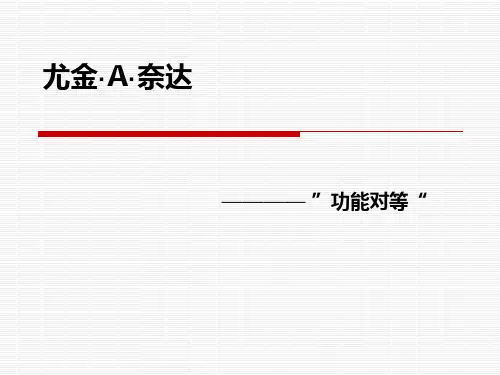
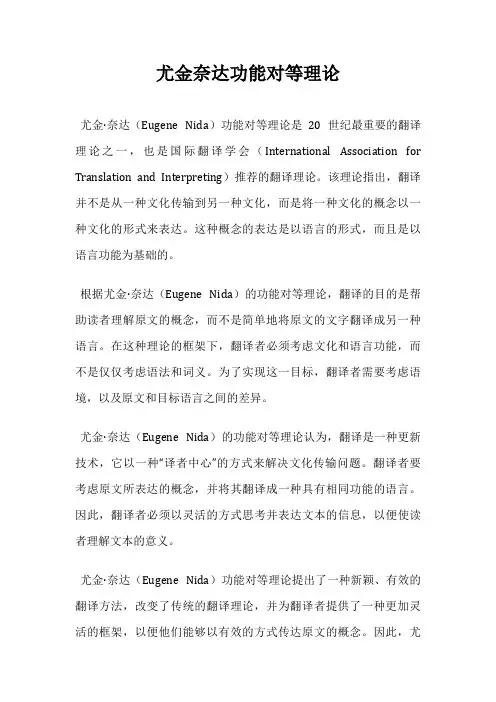
尤金奈达功能对等理论
尤金·奈达(Eugene Nida)功能对等理论是20世纪最重要的翻译理论之一,也是国际翻译学会(International Association for Translation and Interpreting)推荐的翻译理论。
该理论指出,翻译并不是从一种文化传输到另一种文化,而是将一种文化的概念以一种文化的形式来表达。
这种概念的表达是以语言的形式,而且是以语言功能为基础的。
根据尤金·奈达(Eugene Nida)的功能对等理论,翻译的目的是帮助读者理解原文的概念,而不是简单地将原文的文字翻译成另一种语言。
在这种理论的框架下,翻译者必须考虑文化和语言功能,而不是仅仅考虑语法和词义。
为了实现这一目标,翻译者需要考虑语境,以及原文和目标语言之间的差异。
尤金·奈达(Eugene Nida)的功能对等理论认为,翻译是一种更新技术,它以一种“译者中心”的方式来解决文化传输问题。
翻译者要考虑原文所表达的概念,并将其翻译成一种具有相同功能的语言。
因此,翻译者必须以灵活的方式思考并表达文本的信息,以便使读者理解文本的意义。
尤金·奈达(Eugene Nida)功能对等理论提出了一种新颖、有效的翻译方法,改变了传统的翻译理论,并为翻译者提供了一种更加灵活的框架,以便他们能够以有效的方式传达原文的概念。
因此,尤
金·奈达(Eugene Nida)功能对等理论一直是翻译研究的一个重要组成部分,在翻译实践中也得到了广泛的应用。
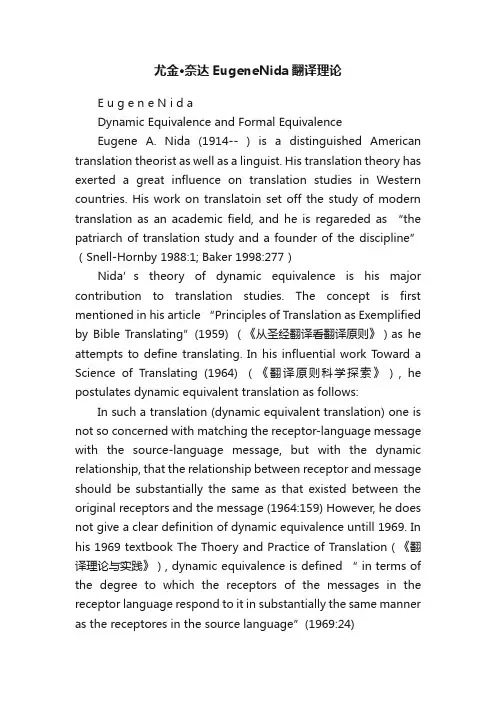
尤金·奈达EugeneNida翻译理论E u g e n e N i d aDynamic Equivalence and Formal EquivalenceEugene A. Nida (1914-- ) is a distinguished American translation theorist as well as a linguist. His translation theory has exerted a great influence on translation studies in Western countries. His work on translatoin set off the study of modern translation as an academic field, and he is regareded as “the patriarch of translation study and a founder of the discipline”(Snell-Hornby 1988:1; Baker 1998:277)Nida’s theory of dynamic equivalence is his major contribution to translation studies. The concept is first mentioned in his article “Principles of Translation as Exemplified by Bible Translating”(1959) (《从圣经翻译看翻译原则》)as he attempts to define translating. In his influential work Toward a Science of Translating (1964) (《翻译原则科学探索》), he postulates dynamic equivalent translation as follows: In such a translation (dynamic equivalent translation) one is not so concerned with matching the receptor-language message with the source-language message, but with the dynamic relationship, that the relationship between receptor and message should be substantially the same as that existed between the original receptors and the message (1964:159) However, he does not give a clear definition of dynamic equivalence untill 1969. In his 1969 textbook The Thoery and Practice of Translation(《翻译理论与实践》), dynamic equivalence is defined “ in terms of the degree to which the receptors of the messages in the receptor language respond to it in substantially the same manner as the receptores in the source language”(1969:24)The expression “dynamic equivalence” is superseded by “functional equivalencev” in his work From One Language to Another (1986, with De Waard)(《从一种语言到另一种语言》). However, there is essentially not much difference between the two concepts. The substitution of “functional equivalence” is just to stress the concept of function and to avoid misunderstandings of the term “dynamic”, which is mistaken by some persons for something in the sense of impact ( Nida 1993:124). In Language, Culture andTranslating(1993)(《语言与文化:翻译中的语境》, “functional equivalence” is further divided into categories on two levels: the minimal level and the maximal level. The minimal level of “functional equivalence” is defined as “The readers of a translated text should be able to comprehend it to the point that they can conceive of how the original readers of the text must have understood and appreciated it”. T he maximal level is stated as “The readers of a translated text should be able to understand and aprreciate it in essentially the same manner as the original readers did” (Nida 1993:118; 1995:224). The two definitions of equivalence reveal that the minimal level is realistic, whereas the maximal level is ieal. For Nida, good translations always lie somewhere between the two levels (Nida 19954:224). It can be noted that “functional equivalence” is a flexible concept with different degrees of adequacy.Dynamic EquivalenceA term introduced by Nida(1964) in the context of Bible translation to describe one of two basic orientations found in the process of translation (see also Formal Equivalence). Dynamic equivalence is the quality which characterizes a translation inwhich “the message of the original text has been so transported into the receptor language that the response of the receptor is essentially like that of the original receptors”(Nida & Taber 1969/1982:200, emphasis removed). In other words, a dynamically equivalent translation is one which has been produced in accordance with the threefold process of Analysis, Transfer and Restructuring (Nida & Taber 1969/1982:200); formulating such a translation will entail such procedures as substituting TL items which are more culturally appropriate for obscure ST items, making lingguistically implicit ST information explicit, and building in a certain amount of REDUNDANCY(1964:131) to aid comprehension. In a translation of this kind one is therefor not so concerned with “matching the receptor-language message with the source-laguage”; the aim is more to “relate the receptor to modes of behavior relevant within the context of his own culture” (Nida 1964:159). Possibly the best known example of a dynamically equivalent solution to a translation problem is seen in the decision to translate the Biblical phrase “Lamb of God” into and Eskimo language as “Seal of God”: the fact that lambs are unkown in polar regions has here led to the substitution of a culturally meaningful item which shares at least some of the important features of the SL expression (see Snell-Hornby 1988/1955:15). Nida and Taber argue that a “high degree” of equivalence of response is needed for the translation to achieve its purpose, although they point out that this response can never be identical with that elicited by the original(1969/1982:24). However, they also issue a warning about the limits within which the processes associated with producing dynamic equivalence remain valid: fore example, a comparison with the broadly simialr category of LinguisticTranslaton reveals that only elements which are linguistically implict in TT-rather than any additional contextual information which might benecessary to a new audience—may legitimately be made explicit in TT. The notion of dynamic equivalence is of course especially relevant to Bible translation, given the particular need of Biblical translations not only to inform readers but also to present a relevant message to them and hopefully elicit a response(1969/1982:24). However, it can clearly also be applied to other genres, and indeed in many areas ( such as literary translation) it has arguably come to hold sway over other approaches (Nida 1964:160). See also Fuctional Equivalence. Further reading: Gut 1991; Nida 1964,1995: Nida & Taber 1969/1982.奈达(Nida)(1964)在《圣经》翻译中所采用的术语,用来描述翻译过程的两个基本趋向之一(另见Formal Equivalence[形式对等])。
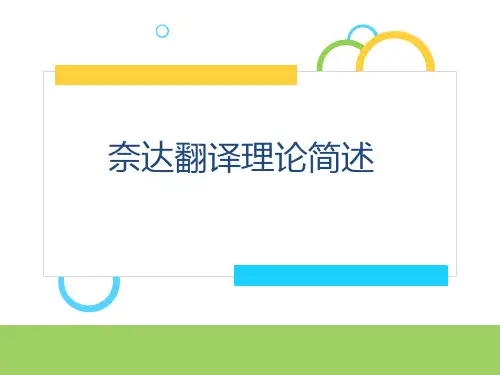
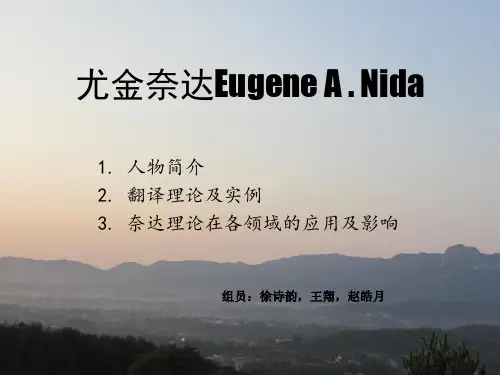
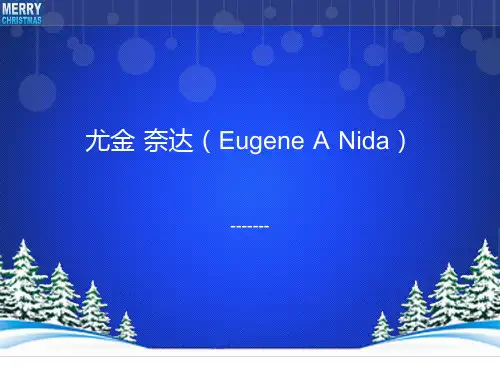
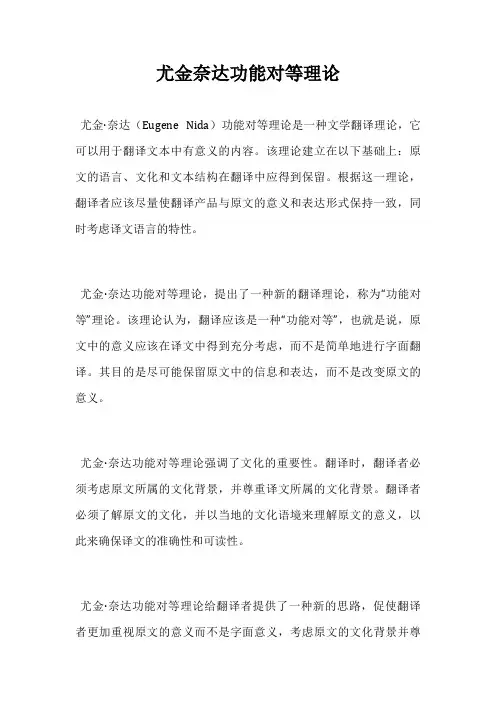
尤金奈达功能对等理论
尤金·奈达(Eugene Nida)功能对等理论是一种文学翻译理论,它可以用于翻译文本中有意义的内容。
该理论建立在以下基础上:原文的语言、文化和文本结构在翻译中应得到保留。
根据这一理论,翻译者应该尽量使翻译产品与原文的意义和表达形式保持一致,同时考虑译文语言的特性。
尤金·奈达功能对等理论,提出了一种新的翻译理论,称为“功能对等”理论。
该理论认为,翻译应该是一种“功能对等”,也就是说,原文中的意义应该在译文中得到充分考虑,而不是简单地进行字面翻译。
其目的是尽可能保留原文中的信息和表达,而不是改变原文的意义。
尤金·奈达功能对等理论强调了文化的重要性。
翻译时,翻译者必须考虑原文所属的文化背景,并尊重译文所属的文化背景。
翻译者必须了解原文的文化,并以当地的文化语境来理解原文的意义,以此来确保译文的准确性和可读性。
尤金·奈达功能对等理论给翻译者提供了一种新的思路,促使翻译者更加重视原文的意义而不是字面意义,考虑原文的文化背景并尊
重译文所属的文化背景,从而使翻译更加准确、自然、流畅。
尤金·奈达功能对等理论可以用于翻译文本中有意义的内容,为翻译者提供了一个全新的视角,提高翻译质量,实现精准的翻译。
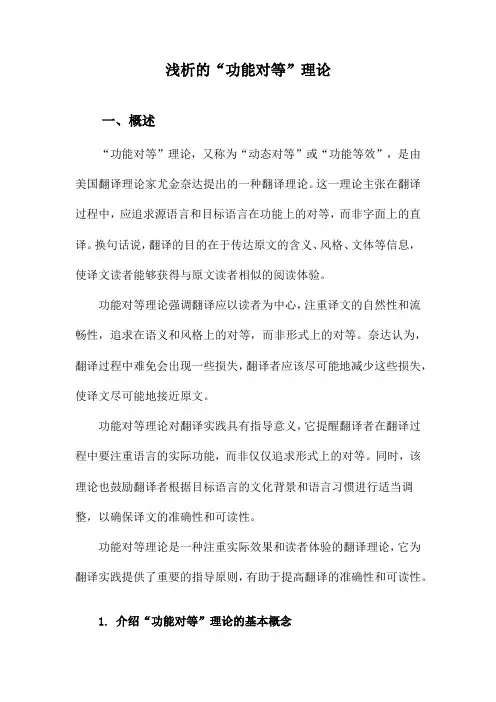
浅析的“功能对等”理论一、概述“功能对等”理论,又称为“动态对等”或“功能等效”,是由美国翻译理论家尤金奈达提出的一种翻译理论。
这一理论主张在翻译过程中,应追求源语言和目标语言在功能上的对等,而非字面上的直译。
换句话说,翻译的目的在于传达原文的含义、风格、文体等信息,使译文读者能够获得与原文读者相似的阅读体验。
功能对等理论强调翻译应以读者为中心,注重译文的自然性和流畅性,追求在语义和风格上的对等,而非形式上的对等。
奈达认为,翻译过程中难免会出现一些损失,翻译者应该尽可能地减少这些损失,使译文尽可能地接近原文。
功能对等理论对翻译实践具有指导意义,它提醒翻译者在翻译过程中要注重语言的实际功能,而非仅仅追求形式上的对等。
同时,该理论也鼓励翻译者根据目标语言的文化背景和语言习惯进行适当调整,以确保译文的准确性和可读性。
功能对等理论是一种注重实际效果和读者体验的翻译理论,它为翻译实践提供了重要的指导原则,有助于提高翻译的准确性和可读性。
1. 介绍“功能对等”理论的基本概念“功能对等”理论,又称为“动态对等”或“功能等效”,是由美国翻译理论家尤金奈达(Eugene Nida)提出的翻译理论核心。
该理论主张在翻译过程中,译文应以实现源语信息的同等功能为目标,而非追求形式上的逐字逐句对应。
功能对等强调译文的读者应能像阅读原文读者一样理解和欣赏译文,即译文应产生与原文相似的反应。
在奈达看来,翻译的首要任务是传达原文的意义,而不仅仅是复制原文的词汇和结构。
他认为,翻译的目的在于实现交际功能,译文必须能够在译语环境中产生与原文在源语环境中相同的效果。
这种对等不是形式上的,而是功能上的,它要求译者在翻译时充分考虑两种语言的文化差异和表达习惯,使译文在语义、风格、文体等方面与原文达到最大程度的对等。
功能对等理论打破了传统翻译理论中“直译”与“意译”的对立,提出了一种全新的翻译观念。
它强调翻译应以实现交际功能为最高准则,而非简单地追求文字上的对应。
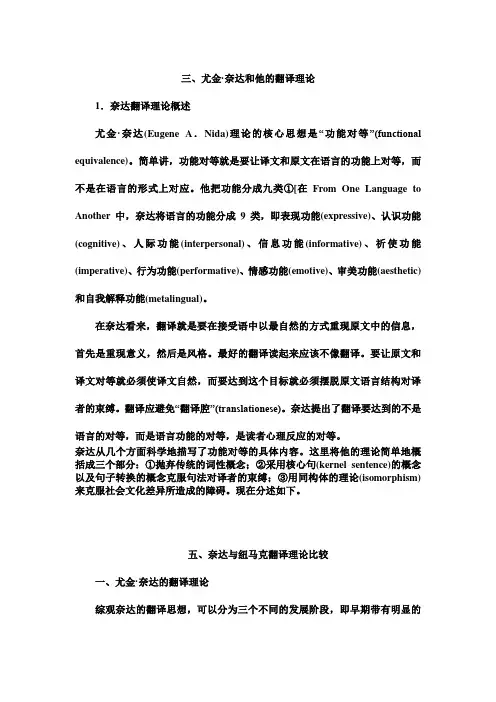
三、尤金·奈达和他的翻译理论1.奈达翻译理论概述尤金·奈达(Eugene A.Nida)理论的核心思想是“功能对等”(functional equivalence)。
简单讲,功能对等就是要让译文和原文在语言的功能上对等,而不是在语言的形式上对应。
他把功能分成九类①[在From One Language to Another中,奈达将语言的功能分成9类,即表现功能(expressive)、认识功能(cognitive)、人际功能(interpersonal)、信息功能(informative)、祈使功能(imperative)、行为功能(performative)、情感功能(emotive)、审美功能(aesthetic)和自我解释功能(metalingual)。
在奈达看来,翻译就是要在接受语中以最自然的方式重现原文中的信息,首先是重现意义,然后是风格。
最好的翻译读起来应该不像翻译。
要让原文和译文对等就必须使译文自然,而要达到这个目标就必须摆脱原文语言结构对译者的束缚。
翻译应避免“翻译腔”(translationese)。
奈达提出了翻译要达到的不是语言的对等,而是语言功能的对等,是读者心理反应的对等。
奈达从几个方面科学地描写了功能对等的具体内容。
这里将他的理论简单地概括成三个部分:①抛弃传统的词性概念;②采用核心句(kernel sentence)的概念以及句子转换的概念克服句法对译者的束缚;③用同构体的理论(isomorphism)来克服社会文化差异所造成的障碍。
现在分述如下。
五、奈达与纽马克翻译理论比较一、尤金·奈达的翻译理论综观奈达的翻译思想,可以分为三个不同的发展阶段,即早期带有明显的美国结构主义色彩的语言学阶段;中期的翻译科学说与翻译交际说阶段,以及后来的社会符号学阶段.1.2.3 动态对等说这是奈达翻译理论中最为人熟知的一种观点。
所谓动态翻译,就是在翻译交际理论指导下的翻译,即“从语义到语体,在接受语中用贴近原文的自然对等语再现源语信息”。
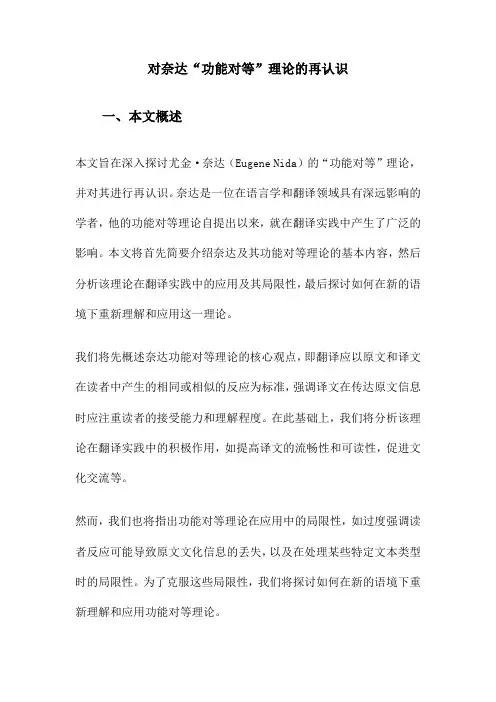
对奈达“功能对等”理论的再认识一、本文概述本文旨在深入探讨尤金·奈达(Eugene Nida)的“功能对等”理论,并对其进行再认识。
奈达是一位在语言学和翻译领域具有深远影响的学者,他的功能对等理论自提出以来,就在翻译实践中产生了广泛的影响。
本文将首先简要介绍奈达及其功能对等理论的基本内容,然后分析该理论在翻译实践中的应用及其局限性,最后探讨如何在新的语境下重新理解和应用这一理论。
我们将先概述奈达功能对等理论的核心观点,即翻译应以原文和译文在读者中产生的相同或相似的反应为标准,强调译文在传达原文信息时应注重读者的接受能力和理解程度。
在此基础上,我们将分析该理论在翻译实践中的积极作用,如提高译文的流畅性和可读性,促进文化交流等。
然而,我们也将指出功能对等理论在应用中的局限性,如过度强调读者反应可能导致原文文化信息的丢失,以及在处理某些特定文本类型时的局限性。
为了克服这些局限性,我们将探讨如何在新的语境下重新理解和应用功能对等理论。
本文旨在通过对奈达功能对等理论的再认识,为翻译实践提供新的视角和思考方法。
我们希望通过深入研究和探讨,为翻译理论的发展和实践的改进做出贡献。
二、奈达“功能对等”理论概述尤金·奈达(Eugene Nida)是西方语言学界著名的翻译理论家,他提出的“功能对等”(Functional Equivalence)理论在翻译界产生了深远的影响。
奈达认为,翻译的目的在于实现源语和目标语之间的功能对等,而非字面上的逐字对应。
他强调,翻译的核心在于传达原文的语义和风格,使目标语读者能够理解和欣赏原文的含义,如同源语读者一样。
在奈达看来,功能对等并非一种绝对的等同,而是一种相对的对等,它允许译者在翻译过程中根据目标语的文化、语境和读者的接受程度进行适当的调整。
这种调整可能涉及词汇的选择、句式的变换、修辞手法的运用等多个方面,以确保译文在目标语中的表达效果与原文在源语中的表达效果尽可能接近。
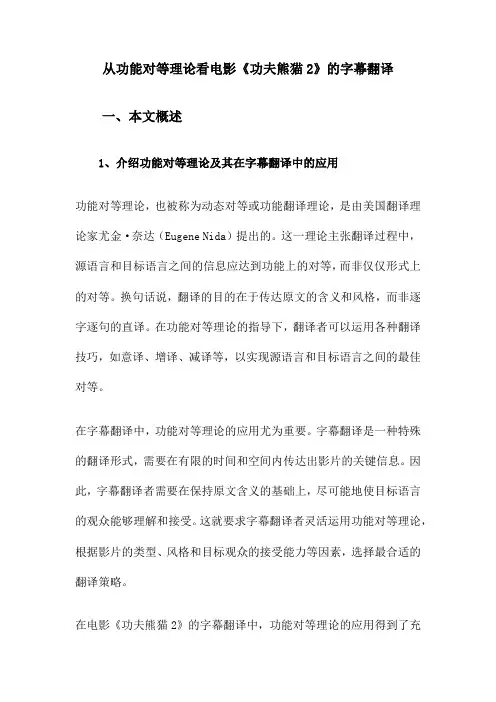
从功能对等理论看电影《功夫熊猫2》的字幕翻译一、本文概述1、介绍功能对等理论及其在字幕翻译中的应用功能对等理论,也被称为动态对等或功能翻译理论,是由美国翻译理论家尤金·奈达(Eugene Nida)提出的。
这一理论主张翻译过程中,源语言和目标语言之间的信息应达到功能上的对等,而非仅仅形式上的对等。
换句话说,翻译的目的在于传达原文的含义和风格,而非逐字逐句的直译。
在功能对等理论的指导下,翻译者可以运用各种翻译技巧,如意译、增译、减译等,以实现源语言和目标语言之间的最佳对等。
在字幕翻译中,功能对等理论的应用尤为重要。
字幕翻译是一种特殊的翻译形式,需要在有限的时间和空间内传达出影片的关键信息。
因此,字幕翻译者需要在保持原文含义的基础上,尽可能地使目标语言的观众能够理解和接受。
这就要求字幕翻译者灵活运用功能对等理论,根据影片的类型、风格和目标观众的接受能力等因素,选择最合适的翻译策略。
在电影《功夫熊猫2》的字幕翻译中,功能对等理论的应用得到了充分体现。
译者通过灵活运用各种翻译技巧,成功地将影片中的关键信息传达给了目标语言的观众,同时保留了影片的幽默风格和文化特色。
这使得目标语言的观众能够在欣赏影片的也能够理解和接受影片中的文化内涵。
2、简要概述电影《功夫熊猫2》及其在中国的影响《功夫熊猫2》是2011年由美国梦工厂动画公司出品的动画电影,是2008年动画电影《功夫熊猫》的续集。
该片由詹妮弗·余执导,杰克·布莱克、安吉丽娜·朱莉、成龙、塞斯·罗根、加里·奥德曼等配音。
该片主要讲述了熊猫阿宝为了追寻自己身世之谜,以及完成自己成为真正功夫高手的梦想,与盖世五侠一起踏上探寻旅程的故事。
在中国,这部电影产生了巨大的影响。
它以其独特的动画设计,尤其是融合了中华传统文化元素,如功夫、熊猫、山水等,吸引了大量观众。
影片中的中国元素不仅让中国观众感到亲切,同时也向世界展示了中国文化的魅力。
奈达翻译理论简介(一)奈达其人尤金?奈达(EugeneA.Nida)1914年出生于美国俄克勒荷马州,当代著名语言学家、翻译家和翻译理论家。
也是西方语言学派翻译理论的主要代表,被誉为西方“现代翻译理论之父”。
尤金是当代翻译理论的主要奠基人,其理论核心是功能对等。
尤金先后访问过90个国家和地区,并著书立说,单独或合作出版了40多部书,比较著名的有《翻译科学探索》、《语言与文化———翻译中的语境》等,他还发表论文250余篇,是世界译坛的一位长青学者。
他还参与过《圣经》的翻译工作。
他与塔伯合著的《翻译理论与实践》对翻译界影响颇深。
此书说明了中国与西方译界人士思维方式的巨大差别:前者是静的,崇尚“信、达、雅”,讲究“神似”,追求“化境”;后者是动的,将语言学、符号学、交际理论运用到翻译研究当中,提倡“动态对等”,注重读者反应。
中国译论多概括,可操作性不强;西方译论较具体,往往从点出发。
他在该书中提到了动态对等,详细地描述了翻译过程的三个阶段:分析、转换和重组,对于翻译实践的作用是不言而喻的。
(二)奈达对翻译的定义按照奈达的定义:“所谓翻译,是指从语义到文体(风格)在译语中用最切近而又最自然的对等语再现源语的信息。
”其中,“对等”是核心,“最切近”和“最自然”都是为寻找对等语服务的。
奈达从社会语言学和语言交际功能的观点出发,认为必须以读者的反应作为衡量译作是否正确的重要标准。
翻译要想达到预期的交际目的,必须使译文从信息内容、说话方式、文章风格、语言文化到社会因素等方面尽可能多地反映出原文的面貌。
他试图运用乔姆斯基的语言学理论建立起一套新的研究方法。
他根据转换生成语法,特别是其中有关核心句的原理,提出在语言的深层结构里进行传译的设想。
奈达提出了词的4种语义单位的概念,即词具有表述事物、事件、抽象概念和关系等功能。
这4种语义单位是“核心”,语言的表层结构就是以“核心”为基础构建的,如果能将语法结构归纳到核心层次,翻译过程就可最大限度地避免对源语的曲解。
Eugene Nida的翻译理论(转)摘要:本文介绍了奈达的翻译思想,对其功能对等理论进行了分析,对奈达理论在翻译界的重要地位和重大影响进行了简单的评述。
然后从五个方面探讨了当今翻译界对奈达思想的争论,介绍了争论中提出的新概念,并进行了一定的分析。
最后,文章探讨了奈达思想形成的原因和在翻译实践中可以得到的启示。
关键词:奈达功能对等争论启示一、奈达的翻译思想尤金·奈达(EugeneA.Nida)是公认的现代翻译理论奠基人之一。
他供职于美国圣经协会,从事圣经翻译和翻译理论研究,其理论在中国甚至在全世界都有着重要的地位。
奈达把翻译看作是一种艺术,力图把语言学应用于翻译研究。
他认为,对翻译的研究应该看作是比较语言学的一个重要的分支;这种研究应以语义为核心包括翻译涉及的各个方面,即我们需要在动态对等的层次上进行这种比较。
由于奈达把翻译和语言学密切联系,他把翻译的过程分成了四个阶段:分析(analysis),转换(transfer),重组(restructuring)和检验(test)。
则翻译的具体过程就经过了下图的步骤。
在这一过程中,奈达实际上是透过对原文的表层结构的分析,理解深层结构并将其转换重组到译文中。
因此,在翻译中所要达到的效果是要让译文读者得到一个自然的译本。
他曾说:“最好的译文读起来应不像翻译。
”所以,他的翻译中另一个非常突出的特点就是“读者反应论”。
他认为,翻译正确与否必须以译文的服务对象为衡量标准,并取决于一般读者能在何种程度上正确地理解译文。
由此,他提出了他的“动态对等理论”。
奈达在《翻译科学探素》(1964)一书中指出,“在动态对等翻译中,译者所关注的并不是源语信息和译语信息的对应关系,而是一种动态关系;即译语接受者和译语信息之间的关系应该与源语接受者和原文信息之间的关系基本相同”。
他认为,所谓翻译,是指从语义到文体在译语中的最贴近而又最自然的对等语再现源语的信息(郭建中,2000)。
奈达功能对等翻译理论(Nida's Functional Equivalence Theory)是基于语言功能和交际目的的翻译理论,由美国翻译学家尤金·奈达(Eugene Nida)提出。
该理论认为,翻译的目的在于传达源语言(原文)的信息,使得译文的接受者能够理解并接受这些信息。
因此,译者应该根据翻译的目的和受众的需求,选择合适的翻译方法,实现翻译的功能对等。
奈达认为,翻译的功能对等可以分为两种类型:动态对等和形式对等。
动态对等(dynamic equivalence)强调翻译的功能目的,即将源语言的信息转化为译语(目标语言)的信息,以达到与原文相同的功能目的。
而形式对等(formal equivalence)则强调词汇和语法结构的相似性,使译文与原文的表面形式尽量相似。
奈达功能对等翻译理论强调了翻译的交际功能,即翻译的主要目的是传达信息,而不是简单地将原文单词和句子的翻译转换为另一种语言。
因此,译者需要考虑到受众的语言和文化背景,选择恰当的语言和表达方式,以实现源语言和目标语言之间的功能对等。
尤金奈达翻译步骤
摘要:
尤金奈达翻译步骤
1.了解尤金奈达翻译理论背景
2.分析尤金奈达翻译步骤
3.总结尤金奈达翻译理论的贡献与不足
正文:
尤金奈达翻译步骤
尤金奈达(Eugene A.Nida)是一位著名的翻译理论家,他的翻译理论以功能翻译为方向,强调翻译过程中信息的传递和功能的实现。
他的翻译步骤可以概括为以下几个方面:
1.分析原文:在翻译开始之前,译者需要对原文进行深入的分析,包括了解原文的文体、语言风格、作者立场和写作目的等,以便在翻译过程中保留原文的功能和风格。
2.确立翻译策略:根据原文分析的结果,译者需要确立相应的翻译策略。
这些策略包括:直译、意译、归化、异化等,以实现翻译的目的。
3.进行翻译:在确立了翻译策略之后,译者可以开始进行实际的翻译工作。
这一阶段需要注意词汇、语法、句子结构等方面的转换,使译文在目标语言中表达清晰、通顺。
4.审校与修改:完成初稿翻译后,译者需要对译文进行审校和修改,确保译文在目标语言和文化背景下忠实于原文,并符合翻译的目的。
5.反馈与调整:在审校过程中,如果发现译文存在问题,译者需要根据反馈进行相应的调整,直至达到满意的翻译效果。
尤金奈达翻译理论的贡献在于,它强调了翻译过程中的功能性和信息传递,使得翻译活动更加注重实现翻译的目的。
然而,这一理论也存在一定的不足,例如在实际操作过程中,如何界定“功能”和“信息”的具体内涵,以及如何在保持原文功能和风格的同时,确保译文的忠实性和通顺性等。
Eugene NidaDynamic Equivalence and Formal EquivalenceEugene A、Nida (1914 ) is a distinguished American translation theorist as well as a linguist、His translation theory has exerted a great influence on translation studies in Western countries、His work on translatoin set off the study of modern translation as an academic field, and he is regareded as “the patriarch of translation study and a founder of the discipline”(SnellHornby 1988:1; Baker 1998:277)Nida’s theory of dynamic equivalence is his major contribution to translation studies、The concept is first mentioned in his article “Principles of Translation as Exemplified by Bible Translating”(1959) (《从圣经翻译瞧翻译原则》) as he attempts to define translating、In his influential work Toward a Science of Translating (1964) (《翻译原则科学探索》), he postulates dynamic equivalent translation as follows:In such a translation (dynamic equivalent translation) one is not so concerned with matching the receptorlanguage message with the sourcelanguage message, but with the dynamic relationship, that the relationship between receptor and message should be substantially the same as that existed between the original receptors and the message (1964:159) However, he does not give a clear definition of dynamic equivalence untill 1969、In his 1969 textbook The Thoery and Practice of Translation(《翻译理论与实践》),dynamic equivalence is defined “in terms of the degree to which the receptors of the messages in the receptor language respond to it in substantially the same manner as the receptores in the source language”(1969:24)The expression “dynamic equivalence”is superseded by “functional equivalencev”in his work From One Language to Another (1986, with De Waard)(《从一种语言到另一种语言》)、However, there is essentially not much difference between the two concepts、The substitution of “functional equivalence”is just to stress the concept of function and to avoid misunderstandings of the term “dynamic”, which is mistaken by some persons for something in the sense of impact ( Nida 1993:124)、In Language, Culture and Translating(1993)(《语言与文化:翻译中得语境》, “functional equivalence” is further divided into categories on two levels: the minimal level and the maximal level、The minimal level of “functional equivalence” is defined as “The readers of a translated text should be able to prehend it to the point that they can conceive of how the original readers of the text must have understood and appreciated it”、The maximal level is stated as “The readers of a translated text should be able to understand and aprreciate itin essentially the same manner as the original readers did” (Nida 1993:118; 1995:224)、The two definitions of equivalence reveal that the minimal level is realistic, whereas the maximal level is ieal、For Nida, good translations always lie somewhere between the two levels (Nida 19954:224)、It can be noted that “functional equivalence” is a flexible concept with different degrees of adequacy、Dynamic EquivalenceA term introduced by Nida(1964) in the context of Bible translation to describe one of two basic orientations found in the process of translation (see also Formal Equivalence)、Dynamic equivalence is the quality which characterizes a translation in which “the message of the original text has been so transported into the receptor language that the response of the receptor is essentially like that of the original receptors”(Nida & Taber 1969/1982:200, emphasis removed)、In other words, a dynamically equivalent translation is one which has been produced in accordance with the threefold process of Analysis, Transfer and Restructuring (Nida & Taber 1969/1982:200); formulating such a translation will entail such procedures as substituting TL items which are more culturally appropriate for obscure ST items, making lingguistically implicit ST information explicit, and building in a certain amount of REDUNDANCY(1964:131) to aid prehension、In a translation of this kind one is therefor not so concerned with “matching the receptorlanguage message with the sourcelaguage”; the aim is more to “relate the receptor to modes of behavior relevant within the context of his own culture” (Nida 1964:159)、Possibly the best known example of a dynamically equivalent solution to a translation problem is seen in the decision to translate the Biblical phrase “Lamb of God” into and Eskimo language as “Seal of God”: the fact that lambs are unkown in polar regions has here led to the substitution of a culturally meaningful item which shares at least some of the important features of the SL expression (see SnellHornby 1988/1955:15)、Nida and Taber argue that a “high degree”of equivalence of response is needed for the translation to achieve its purpose, although they point out that this response can never be identical with that elicited by the original(1969/1982:24)、However, they also issue a warning about the limits within which the processes associated with producing dynamic equivalence remain valid: fore example, a parison with the broadly simialr category of Linguistic Translaton reveals that only elements which are linguistically implict in TTrather than any additional contextual information which might be necessary to a new audience—may legitimately be made explicit in TT、The notion of dynamic equivalence is of course especially relevant to Bible translation, given the particular need of Biblical translations not only to inform readers but also to present a relevant message to them and hopefully elicit aresponse(1969/1982:24)、However, it can clearly also be applied to other genres, and indeed in many areas ( such as literary translation) it has arguably e to hold sway over other approaches (Nida 1964:160)、See also Fuctional Equivalence、Further reading: Gut 1991; Nida 1964,1995: Nida & Taber 1969/1982、奈达(Nida)(1964)在《圣经》翻译中所采用得术语,用来描述翻译过程得两个基本趋向之一(另见Formal Equivalence[形式对等])。